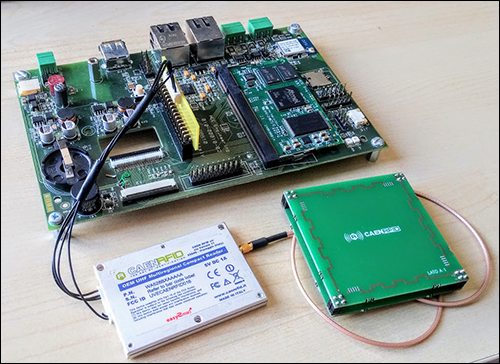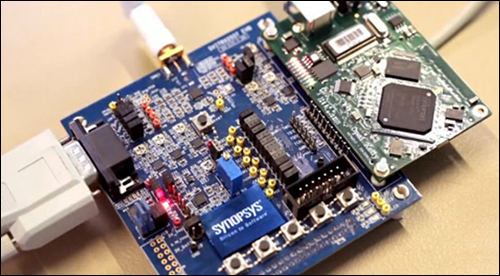The following are news announcements made during the past week by the following organizations:
CAEN RFID, HCE Engineering;
Marine Transport International, Agility Sciences;
Synopsys;
STMicroelectronics, MediaTek;
FreeWave Technologies, the Mount Washington Observatory;
Identiv, and nXient.
CAEN RFID, HCE Engineering Offers Industrial RAIN RFID Kit
CAEN RFID and HCE Engineering have announced their Enigma Industrial RAIN RFID Kit. According to the two companies, the integrated solution is designed for reading RAIN RFID tags based on the GNU/Linux operating system.
HCE Engineering designs and produces industrial embedded systems and professional electronics. CAEN RFID designs and creates ultrahigh-frequency (UHF) RFID readers and tags, and was the first company in Europe to produce and distribute UHF readers. Both companies are headquartered in Italy.

The Enigma Industrial RAIN RFID Kit comes with the Debian 8.0 operating system, as well as software for users to develop their own RAIN RFID applications. It includes a 24-volt DC power supply, standard connectors and a thin-film-transistor (TFT) panel with an RGB interface (up to 24-bit colors). The kit is intended for use with graphic terminals and human-machine interface panels with a 4.3- to 10-inch touchscreen.
The system can be expanded with input-output cards via an RS485 interface with Modbus RTU (the Modbus TCP is available via an Ethernet interface), a CAN 2.0B interface (up to 1 megabyte per second) or its own expansion connector. In addition, the system supports two RJ45 Ethernet connectors (one offering 10 or 100 megabytes per second, the other 10, 100 or 1,000 megabytes per second) and an optional IEEE 802.11 b/g/n Wi-Fi interface with speeds of up to 72 megabytes per second.
Marine Transport International, Agility Sciences Deploy Blockchain System for Logistics
Marine Transport International (MTI) has announced that a successful pilot program has demonstrated how the logistics industry can improve connectivity, efficiency and security using blockchain technology. MTI, in conjunction with Agility Sciences, have released a whitepaper detailing the deployment of their Container Streams system in a supply chain environment. The pilot’s results have been verified by scientists at the University of Copenhagen and maritime technology leads at the Blockchain Labs for Open Collaboration (BLOC).
The project, which has connected supplier, shipper, load point, customs and terminal on a shared blockchain ledger, has far-reaching consequences for the logistics industry, the companies report. All parties involved in the supply chain benefit from automated data flows, as the system allows complete interoperability of data sources, including legacy systems.
“The results of this successful pilot demonstrate the strengths of blockchain technology when deployed to link the various actors in the supply chain,” said Jody Cleworth, Marine Transport International’s CEO, in a prepared statement. “We are confident that firms throughout the logistics industry will see a broad spectrum of benefits stemming from blockchain deployment… A blockchain-enabled supply chain is highly resilient to cyberattack; a copy of the essential shipping data is stored on each node on a decentralized network, meaning that even if one node is compromised, the data is safe nevertheless.”
“This pilot demonstrates the great potential for distributed ledger technologies to be used in improving supply chain processes,” said Karim Jabbar, from the University of Copenhagen’s Department of Computer Science, in the prepared statement. “The Container Streams system is unique in the fact that it does not require the complete replacement of existing systems; instead, MTI’s solution allows complete interoperability with existing legacy infrastructure. The logistics industry as a whole can expect better visibility, connectivity and cost savings as a result of distributed ledger adoption.”
Deanna MacDonald, BLOC’s CEO, added in the statement: “We have documented the first phase of this use case, its implications for the maritime industry and the resulting development of a turnkey application ecosystem for global supply chain logistics. However, the future potential of this ecosystem platform will rest upon collaboration from the different actors in these supply chains in order to clearly identify the problems and co-create applications that solve for the collective challenges they are facing today.”
Synopsys BLE System Achieves Bluetooth 5 Qualification
Synopsys has announced that its DesignWare Bluetooth Low Energy Link Layer IP and PHY IP has achieved Bluetooth 5 qualification and been declared compliant by the Bluetooth Special Interest Group. This qualification signifies that it functions properly within a system-on-chip (SoC).
The DesignWare Bluetooth IP solution has been validated with third-party software stack providers, including SEARAN, to provide designers with a complete hardware and software solution. The IP has been tested in third-party interoperability workshops to ensure that it operates reliably in real-world environments. DesignWare Bluetooth Low Energy PHY IP delivers up to a 60 percent smaller area compared to the previous Bluetooth PHY solution, the company reports, providing designers with a compact, low-power wireless IP solution for such Internet of Things (IoT) applications as medical, smart appliances, smart thermostats and wearables.

“SEARAN and Synopsys are addressing our mutual customers’ low energy wireless connectivity needs by providing a proven, complete Bluetooth 5 IP solution,” said Arkady Pittel, SEARAN’s president and CEO, in a prepared statement. “The integrated solution, consisting of SEARAN’s compact dotstack and Synopsys’ DesignWare Bluetooth Low Energy Link Layer IP and PHY IP, allows designers to quickly bring differentiated Bluetooth-based products to the fast moving IoT market.”
Synopsys’ Bluetooth 5 Link Layer and PHY IP solutions support Bluetooth mesh and enable secure wireless connectivity with extended reach, and data rates up to 2 megabytes per second with an integrated on-chip transceiver matching network. The PHY also supports the IEEE 802.15.4 standard for connectivity over wireless networks such as ZigBee or Thread.
“Connected devices like wearables, smart locks and smart thermostats require Bluetooth technology to communicate wirelessly at extremely low power,” said John Koeter, Synopsys’ VP of marketing for IP, in the prepared statement. “By providing a silicon-proven and qualified Bluetooth Low Energy Link Layer and PHY IP solution, Synopsys enables designers to integrate the required functionality into their SoCs to ensure compliance, interoperability and robustness of their designs.”
STMicroelectronics, MediaTek Combine NFC Technology, Mobile Platform
STMicroelectronics, a global semiconductor company, has announced the integration of its contactless Near Field Communication (NFC) technology with MediaTek’s mobile platforms. This integration, the company reports, enables handset developers to design smartphones capable of supporting tightly integrated NFC mobile services.
By integrating ST’s NFC chipset with MediaTek’s mobile platforms, the two partners can help mobile original equipment manufacturers (OEMs) overcome key technical challenges. These include antenna design and integration, antenna miniaturization, and bill-of-material optimization. The system also assures interoperability with payment terminals at retailers, transportation hubs and other locations.
“ST will provide its NFC technology to MediaTek, to deliver high contactless performance solutions to OEMs with a focus on cost and integration optimization through smaller antennas and reduced bill of materials,” said Marie-France Florentin, the group VP and general manager of ST’s Secure Microcontroller Division, in a prepared statement. “While ST has for years been providing to customers its own robust NFC and RFID technology, the ST21NFCD is the first device from ST to integrate the market-proven booster technology ST recently acquired.”
Industrial IoT Solutions from FreeWave Technologies Provide Weather Data for Mount Washington Observatory
FreeWave Technologies, a provider of industrial, secure machine-to-machine (M2M) and Internet of Things (IoT) wireless networking solutions, has announced that its ruggedized industrial IoT (IIoT) data radios deliver real-time weather data at the Mount Washington Observatory (MWO), a New Hampshire-based non-profit research facility.
MWO conducts critical weather, atmospheric and climate research that is used for national and global forecasting. The facility provides vital data that allows local government agencies to assess active conditions in order to protect the lives of crews during search-and-rescue operations. FreeWave’s low-power 900 MHz radios are designed to provide critical data under Mount Washington’s extreme weather and harsh conditions, according to the company.

“As you can imagine, there is little to no room for failure when it comes to our climate monitoring efforts that double as a resource to help save lives during search operations,” said Peter Gagne, Mount Washington Observatory’s IT manager, in a prepared statement. “For more than 13 years, FreeWave’s radios have impressed us with their durability and reliability in some of the most extreme conditions on the planet. We’ve been so pleased with their performance that we will continue to deploy FreeWave as we update our Auto Road Vertical Profile this year. To top it off, we receive top-notch customer service, and the network is cost-effective and easy to deploy.”
MWO has studied Earth’s climate since 1932. The facility sits atop the highest peak in the Northeast United States, at an elevation of 6,288 feet. Researchers frequently encounter winds at 50 to 100 miles per hour and penetrating fog in the summer, as well as sub-arctic temperatures, winds at 140 miles per hour or more, freezing fog and heavy glaze icing in the winter. Weather conditions change frequently and rapidly, visibility is often compromised, and researchers have seen ice accretion rates of up to 12 inches per hour.
At the observatory, FreeWave’s FGR and FGR2 radios connect a network of 28 sensors and devices on five remote weather stations. The stations are solar-powered and only receive sunlight 40 percent of the year. The system’s capabilities have enabled 24-hour, year-round network connectivity, the company reports.
Identiv, nXient Expand Physical Security, Identity Management Solutions
Identiv has announced its partnership with nXient to expand security and identity-management solutions in the Australian and New Zealand markets. nXient has launched integration software that harnesses Identiv’s Hirsch Velocity access-control system and Mobotix‘s closed-circuit television (CCTV) system. The integration uses Identiv’s Hirsch Velocity Video Framework application programming interface (API) and Mobotix’s native video codec, MxPeg.
Identiv’s Hirsch Velocity Software is an integrated platform that manages access-control and security operations at thousands of facilities, the company reports, ranging from single, high-secure rooms to multi-building, multi-location campuses. “For the first time ever, these advanced access control and video surveillance systems can seamlessly interact for powerful results and cost savings,” said Ross Head, nXient’s founder and CEO, in a prepared statement. “The nXient integration for Hirsch Velocity provides incredible integration for the Mobotix video management system. Powerful and simple to operate, this integration ensures you won’t miss a thing—all events contain video with full audio recording.”
In nXient’s software integration, the Hirsch Velocity platform provides the core functionality of the video framework and APIs for extending Velocity’s use of real-time video resources. MxPeg and Mobotix’s API provide direct communication with each 6-megapixel, high-resolution, IP-based CCTV camera, allowing bidirectional triggers of motion events, activity sensors and alarms, and the ability to store video and audio tagged to alarms within Velocity.
“Identiv is thrilled to be revolutionizing physical security and identity management with nXient,” said Mark Allen, Identiv’s general manager for physical access, in the prepared statement. “nXient’s software integration extends the overall functionality of our Hirsch access control system and Mobotix’s CCTV system, adding greater real-time situational awareness so a facility can respond to events quickly and more effectively.”

